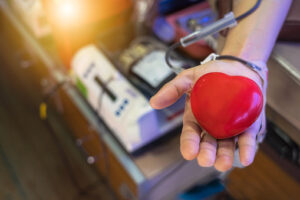Donors who experience a vasovagal reaction are less likely to return for subsequent donations, and this is especially true in younger or newer donors. Since vasovagal reactions are thought to be triggered by both a drop in arterial blood pressure and psychological stress and fear, researchers in The Netherlands organized a pragmatic cluster-assigned intervention study to determine whether drinking water (330 ml or 500 ml) or ball squeezing before phlebotomy (placebo) would reduce vasovagal reactions compared to a control group. From December 2014 to September 2016, 6538 of 8300 (78.9%) donors < 30 years of age enrolled in the study returned within 421 days to donate again. The odds of return were higher for both groups of donors who drank water and those who squeezed a ball before donating compared to the control group without extra interventions (odds ratio [OR] 1.14, 95% CI 1.00-1.29 and OR 1.22, 95% CI 1.05-1.43, respectively). Extra interventions—be it extra water or the placebo ball squeezing—helped to increase donor return rate, presumably through psychological mechanisms. Blood collection organizations should prioritize donor satisfaction and experience to minimize complications and maximize donor retention.
Reference:

